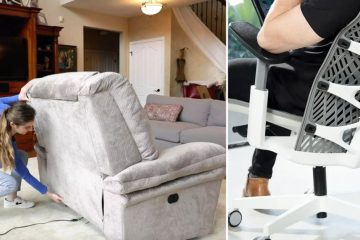As individuals age, their joints may weaken, making it challenging for them to stand up from a seated position. Assisting an elderly person in getting up from a chair requires careful consideration of their needs and safety. In this comprehensive guide, we will explore various techniques, tools, and precautions on how to help an elderly person up from a chair. By following these guidelines, you can provide the necessary support while minimizing the risk of injury to both you and your loved one.
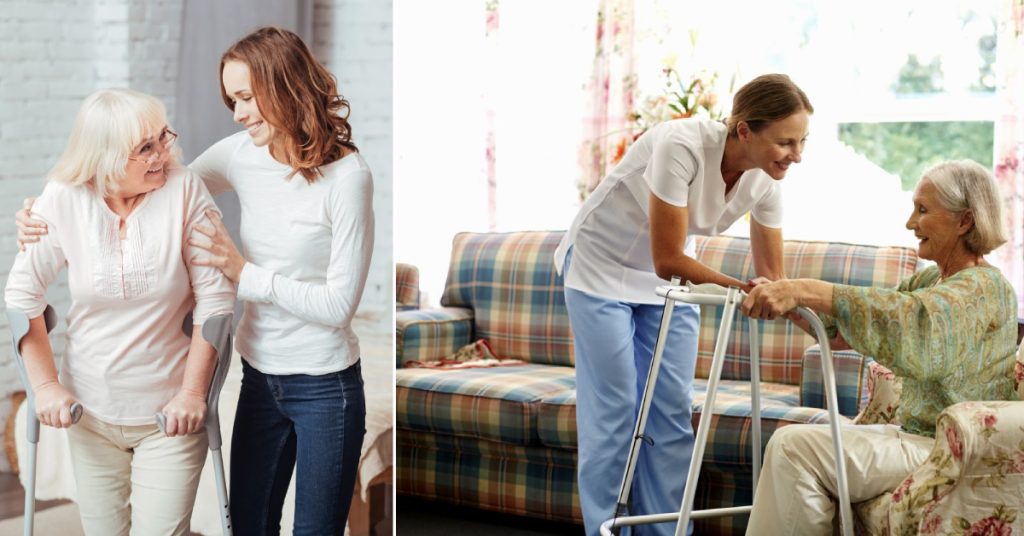
Understanding the Challenges
Before discussing the techniques to help an elderly person get up from a chair, it’s essential to understand the factors that contribute to their difficulty in standing. Several reasons can make this task challenging, including:
- Fear of falling: The fear of potential falls can hinder an elderly person’s confidence in their ability to stand up independently.
- Improper technique: Using incorrect lifting techniques can strain both the caregiver and the person being assisted, leading to potential injuries.
- Limited range of motion: Reduced flexibility in the ankles and knees, along with stiffness in the back and hamstring muscles, can make standing up more challenging.
- Poor balance: Age-related balance issues can make it harder for seniors to maintain stability while transitioning from a seated to a standing position.
- Weakness in the legs: Muscle weakness in the legs can significantly impact an individual’s ability to rise from a chair.
8 Easy Steps for How to Help an Elderly Person Up From a Chair
When assisting an elderly person in standing up from a chair, it is crucial to prioritize safety and ensure clear communication. Here are step-by-step instructions to help you perform this task effectively:
Step 1: Clear the Path
Before initiating the transfer, ensure that the area around the chair is free from any obstacles that may pose a tripping hazard for both you and the individual you are assisting.
Step 2: Communicate Clearly
Speak clearly and calmly, explaining the process to alleviate any anxiety your loved one may have. Ensure they understand your instructions before proceeding.
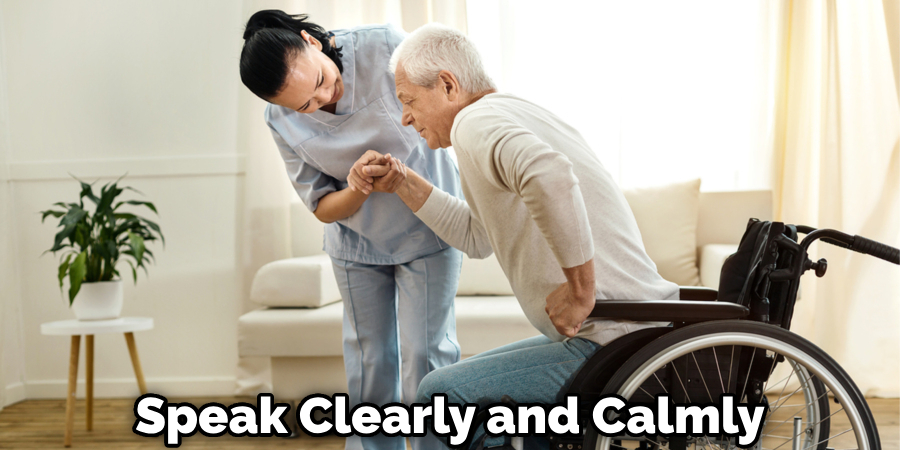
Step 3: Proper Positioning
Stand in front of the chair with one foot slightly ahead for stability. Encourage the person to sit near the front edge of the chair, as this will facilitate the transfer.
Step 4: Use Your Legs
Instead of relying on your back, use your leg muscles to lift. Bend your knees, keeping your back as straight as possible. This technique reduces strain on your back and transfers the force to your lower body.
Step 5: Support and Stability
Place one arm around the person’s torso, ensuring a secure grip. Have them clasp their hands together over your arm for added stability.
Step 6: Lift Gradually
Slowly and steadily lift, using the strength of your legs. Maintain a straight back throughout the lifting process to avoid unnecessary strain.
Step 7: Encourage Active Participation
Encourage the person to use their leg muscles and assist as much as they can while standing up. This promotes independence and helps maintain their strength.
Step 8: Ensure Balance
Once the person is standing, provide support as needed to ensure their balance. If necessary, assist them in transitioning to a walker or holding onto a stable surface for further support.
It is important to note that these techniques should be adapted to the specific needs and abilities of the individual you are assisting. Always prioritize their comfort and safety throughout the process.
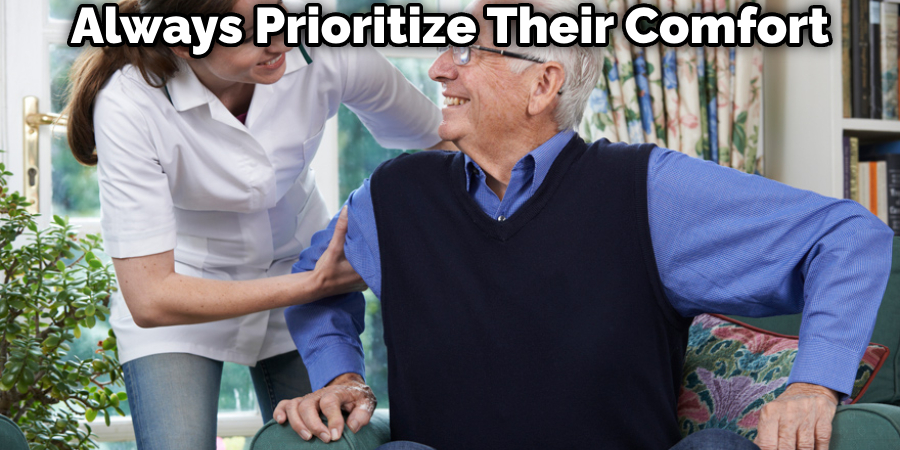
8 Effective Assisting with Assistive Devices
In addition to proper lifting techniques, various assistive devices can aid in helping an elderly person get up from a chair. These devices provide additional support and stability, ensuring a safer transfer. Consider the following options:
1. Chair Assist Tools
Portable and affordable, chair assist tools come in different variations, such as battery-operated or inflatable options. They provide an extra boost for individuals who struggle to stand up independently.
2. Canes or Walkers
Canes and walkers with sturdy bases can provide stability and support during the transition from a seated to a standing position. Ensure they are adjusted to the appropriate height for optimal assistance.
3. Furniture Raisers
These devices elevate the height of furniture, reducing the distance between the seat and the standing position. By raising the chair, seniors don’t have to lower themselves as much when sitting down, making it easier to stand up.
4. Grab Bars
Install screw or suction grab bars near chairs to offer individuals a secure handhold while lifting themselves up. These bars can be strategically placed to provide support where it is most needed.
5. Lift Chairs
Designed specifically for seniors, lift chairs have built-in mechanisms that assist in standing up. With the push of a button, the chair gradually lifts the person to a standing position, reducing the effort required.
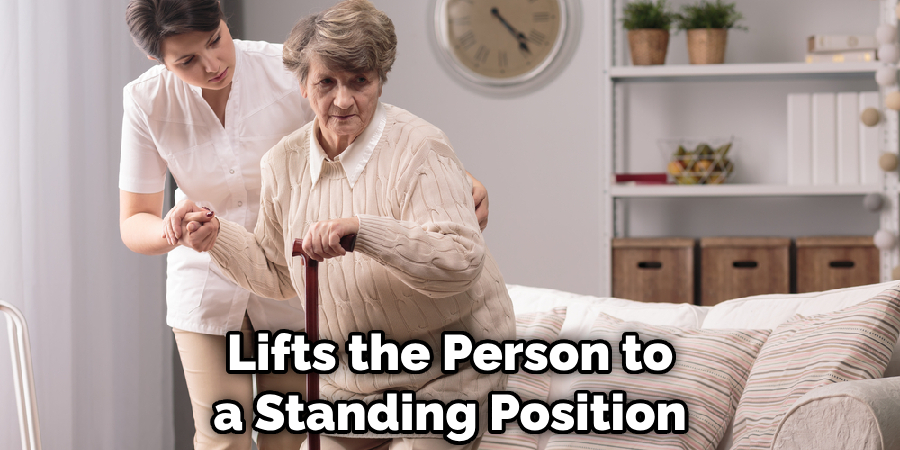
6. Raised Toilet Seats and Toilet Frames
Raising the height of the toilet seat can make it easier for seniors to transition from a seated to a standing position. Raised toilet seats or toilet frames provide added support and stability.
7. Couch Standing Aids
These devices, placed underneath couches or chairs, come equipped with attached grab bars that facilitate standing up. They provide additional leverage and support for the individual.
8. Bed Standing Aids
Similar to couch-standing aids, bed-standing aids can be placed under mattresses, offering support and stability when getting out of bed.
These assistive devices are designed to address specific needs and can greatly enhance an elderly person’s ability to stand up from a chair independently or with minimal assistance. Consulting with a healthcare professional or occupational therapist can help determine the most suitable options for your loved one.

FAQs About How to Help an Elderly Person Up From a Chair
What to Do When an Old Person Falls Down?
When an elderly person falls down, it is important to stay calm and assess the situation. First, ask the person if they are hurt and if they can get up on their own. If there are serious injuries, call 911 immediately. If the person can get up on their own, they should do so slowly and with caution.
If assistance is needed, two people should work together to help the person get up, being careful not to injure themselves or the person who fell. After the fall, watch for any signs of injuries such as bruising or skin discoloration, and seek medical attention if necessary. It is also important to figure out why the person fell and take steps to prevent future falls, such as removing tripping hazards and improving lighting.
What is the First Aid for Falls in the Elderly?
When providing first aid for falls in the elderly, it is important to approach the situation calmly and reassuringly. Carefully help them into a sitting position, watching for any signs of pain, discomfort, or dizziness. If the person can get up on their own, they should do so slowly and with caution. However, if there are serious injuries, it is crucial to call 911 immediately. If assistance is needed, two people should work together to help the person get up, taking care not to injure themselves or the person who fell.
After the fall, it is important to watch for signs of injuries such as bruising or skin discoloration and seek medical attention if necessary. Additionally, it is crucial to identify the reason for the fall and take steps to prevent future falls, such as removing tripping hazards and improving lighting.
What to Do When 80 Year Old Falls?
When an 80-year-old person falls, it is important to stay calm and assess the situation. Approach the person calmly and reassure them while helping them into a sitting position, watching for any signs of pain or dizziness. If there are no obvious injuries or medical causes, encourage them to stay still and wait for further assessment.
Seek immediate medical attention if there are signs of injury. Keep the person warm and provide reassurance while waiting for assistance. After the fall, it is advisable to see a doctor to check for any underlying health issues. Take preventive measures to avoid future falls by removing hazards and promoting regular exercise. Seeking medical attention and prevention are crucial for the well-being of the elderly after a fall.
Conclusion
Assisting an elderly person in getting up from a chair requires careful consideration of their specific needs and safety. By using proper lifting techniques, maintaining clear communication, and incorporating assistive devices when necessary, you can help facilitate a safer and more comfortable transfer. Always prioritize the individual’s comfort, dignity, and independence, ensuring their well-being throughout the process. With the right approach and support, you can make a significant difference in their daily life and mobility.
Remember, it is crucial to consult with healthcare professionals or occupational therapists to assess the specific needs and abilities of the individual you are assisting. They can provide personalized recommendations and guidance to ensure the safest and most effective transfer techniques are employed.

